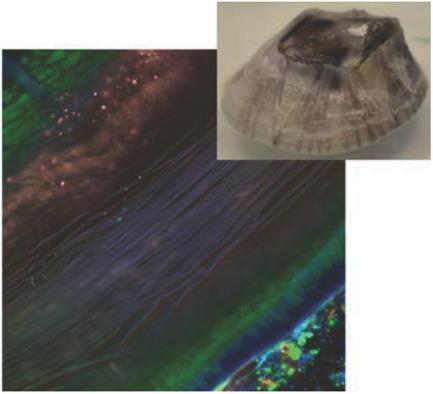Our official English website, www.x-mol.net, welcomes your feedback! (Note: you will need to create a separate account there.)
Acorn Barnacles Secrete Phase‐Separating Fluid to Clear Surfaces Ahead of Cement Deposition
Advanced Science ( IF 15.1 ) Pub Date : 2018-03-14 , DOI: 10.1002/advs.201700762 Kenan P. Fears 1 , Beatriz Orihuela 2 , Daniel Rittschof 2 , Kathryn J. Wahl 1
Advanced Science ( IF 15.1 ) Pub Date : 2018-03-14 , DOI: 10.1002/advs.201700762 Kenan P. Fears 1 , Beatriz Orihuela 2 , Daniel Rittschof 2 , Kathryn J. Wahl 1
Affiliation

|
Marine macrofoulers (e.g., barnacles, tubeworms, mussels) create underwater adhesives capable of attaching themselves to almost any material. The difficulty in removing these organisms frustrates maritime and oceanographic communities, and fascinates biomedical and industrial communities seeking synthetic adhesives that cure and hold steadfast in aqueous environments. Protein analysis can reveal the chemical composition of natural adhesives; however, developing synthetic analogs that mimic their performance remains a challenge due to an incomplete understanding of adhesion processes. Here, it is shown that acorn barnacles (Amphibalanus (=Balanus) amphitrite) secrete a phase‐separating fluid ahead of growth and cement deposition. This mixture consists of a phenolic laden gelatinous phase that presents a phase rich in lipids and reactive oxygen species at the seawater interface. Nearby biofilms rapidly oxidize and lift off the surface as the secretion advances. While phenolic chemistries are ubiquitous to arthropod adhesives and cuticles, the findings demonstrate that A. amphitrite uses these chemistries in a complex surface‐cleaning fluid, at a substantially higher relative abundance than in its adhesive. The discovery of this critical step in underwater adhesion represents a missing link between natural and synthetic adhesives, and provides new directions for the development of environmentally friendly biofouling solutions.
中文翻译:

橡子藤壶在水泥沉积前会分泌相分离液以清除表面
海洋大污物(例如,藤壶,夜蛾,贻贝)会产生能够将自身附着到几乎任何物质上的水下胶粘剂。去除这些生物的困难使海洋和海洋学界感到沮丧,并使寻求在水性环境中固化并保持牢固的合成胶粘剂的生物医学和工业界着迷。蛋白质分析可以揭示天然胶粘剂的化学成分;然而,由于对粘附过程的不完全了解,开发模仿其性能的合成类似物仍然是一个挑战。在这里,显示了橡子藤壶(Amphibalanus(= Balanus)amphitrite)在生长和水泥沉积之前分泌出一种相分离流体。该混合物由含酚的凝胶状相组成,该相在海水界面处呈现出富含脂质和活性氧的相。随着分泌的进行,附近的生物膜会迅速氧化并从表面抬起。尽管节肢动物胶粘剂和表皮中普遍存在酚类化学物质,但研究结果表明,amphitrite A. amphitrite在复杂的表面清洁液中使用这些化学物质,其相对丰度远高于其粘合剂中的相对丰度。水下粘合这一关键步骤的发现代表了天然粘合剂和合成粘合剂之间的缺失环节,并为开发环保型生物污垢解决方案提供了新的方向。
更新日期:2018-03-14
中文翻译:

橡子藤壶在水泥沉积前会分泌相分离液以清除表面
海洋大污物(例如,藤壶,夜蛾,贻贝)会产生能够将自身附着到几乎任何物质上的水下胶粘剂。去除这些生物的困难使海洋和海洋学界感到沮丧,并使寻求在水性环境中固化并保持牢固的合成胶粘剂的生物医学和工业界着迷。蛋白质分析可以揭示天然胶粘剂的化学成分;然而,由于对粘附过程的不完全了解,开发模仿其性能的合成类似物仍然是一个挑战。在这里,显示了橡子藤壶(Amphibalanus(= Balanus)amphitrite)在生长和水泥沉积之前分泌出一种相分离流体。该混合物由含酚的凝胶状相组成,该相在海水界面处呈现出富含脂质和活性氧的相。随着分泌的进行,附近的生物膜会迅速氧化并从表面抬起。尽管节肢动物胶粘剂和表皮中普遍存在酚类化学物质,但研究结果表明,amphitrite A. amphitrite在复杂的表面清洁液中使用这些化学物质,其相对丰度远高于其粘合剂中的相对丰度。水下粘合这一关键步骤的发现代表了天然粘合剂和合成粘合剂之间的缺失环节,并为开发环保型生物污垢解决方案提供了新的方向。



























 京公网安备 11010802027423号
京公网安备 11010802027423号